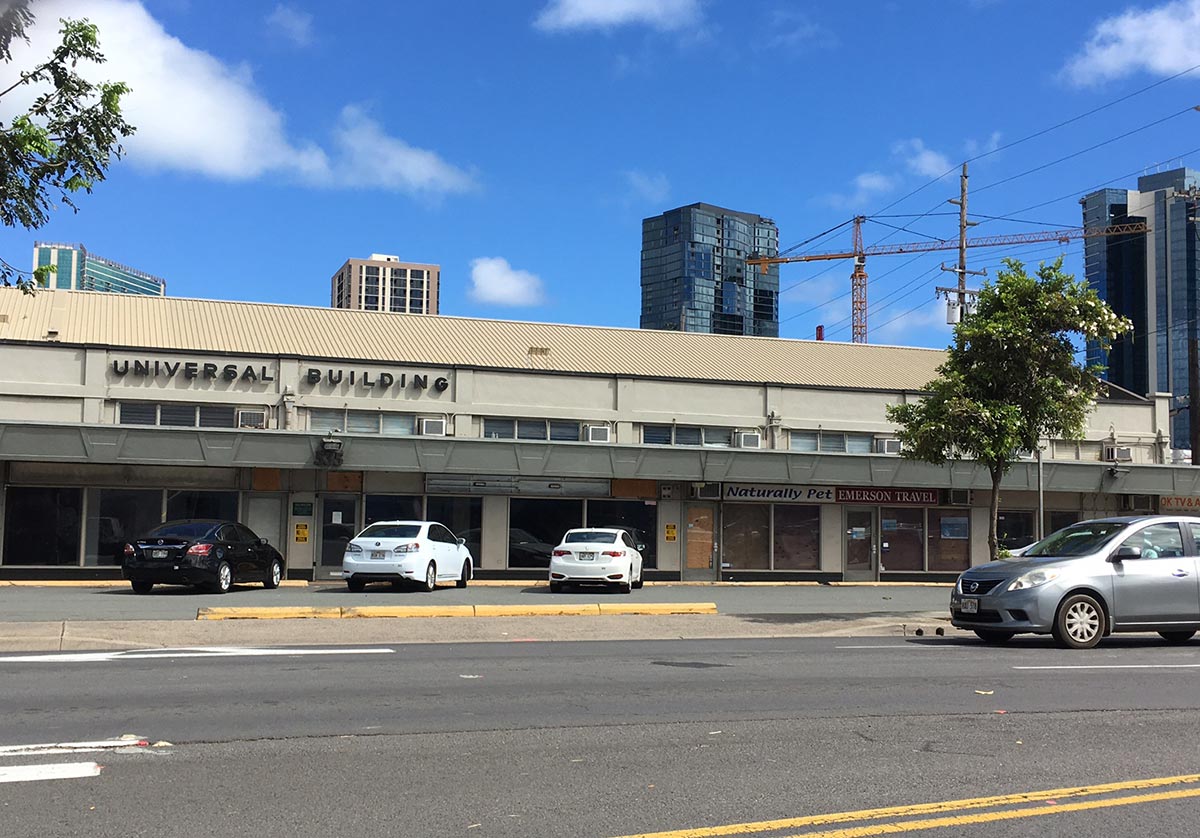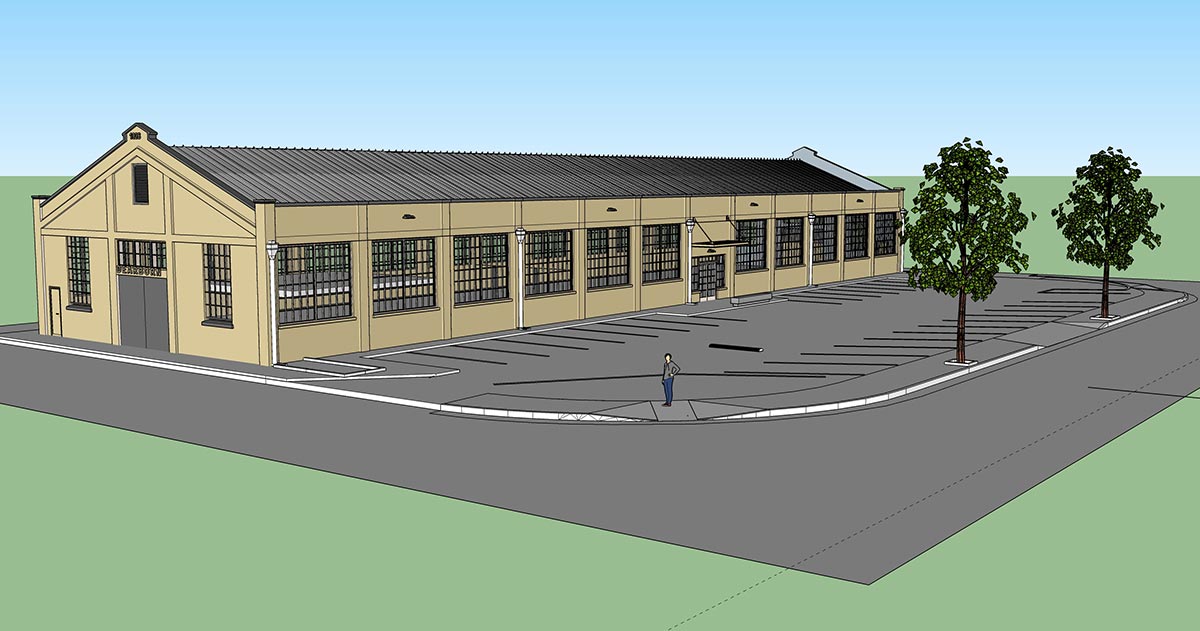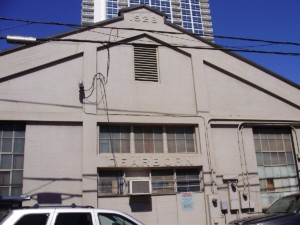
8/31/2018: A 90-year-old building that harkens to Kakaako’s industrial past will find new life as a retail center through a historic rehabilitation project being presented to the Board of Hawaii Community Development Authority on September 5.
The Dearborn Building, also known as the Universal Building, is located on Ward Avenue between Waimanu and Kawaiahao Streets. Originally built in 1928 for the Dearborn Chemical Company, the warehouse now stands as a rare surviving example of a light industrial, masonry building from the pre-World War II period to still exist in the Kakaako district.
After several decades of use by Dearborn, by the mid-1960s, the warehouse/industrial use had ended and the building was converted to retail and office use. It is assumed that the building name was changed to the Universal Building at the time an addition was added to the entire length of the exterior, circa 1965.
Dearborn 535 LLC purchased the building in 2014 and plans to preserve, rehabilitate and make adaptive reuse of the building. Dearborn 535 LLC’s comprehensive preservation strategy includes nominating the property to be listed on both the Hawaii and National Registers of Historic Places; design and construction work to comply with the Secretary of the Interior’s Standards for the Rehabilitation of Historic Properties; and placing a conservation easement on the historic property to surrender future development rights in favor of perpetual preservation.
“A vibrant and renewed Kakaako must include a neighborhood in which historic buildings are preserved, rehabilitated and used for a variety of community needs,” said Kiersten Faulkner, executive director of Historic Hawaii Foundation. “Buildings of human scale are part of a mix that creates a walkable community with a tapestry of the history, culture, design, and values that are embodied in the buildings that currently exist.”

The owner has engaged DKKY Architecture Studio Inc. to develop rehabilitation plans for the building. The intention is to return the building to its 1930’s appearance by removing the front addition and restoring the window wall; removing the door infill on the Kawaiahao Street elevation and restoring the sliding door; and removing a portion of the mezzanine level and interior wall to restore the open floor plan in the interior.
“We were really excited to find most of the original glass windows still there,” said architect Davidean Young. “We will be able to restore the missing window wall using the original glass panes or by replicating them following the original fenestration pattern. We also plan to replicate the missing sliding door on the Kawaihao elevation by using the existing door on Waimanu as a template.”
The Ward Avenue side of the parcel would remain the surface parking lot, with additional parking spaces and loading zone in the area currently used by the front addition.
Building systems to bring the property to contemporary standards for usability and adaptive use will follow standards and guidelines for the modification of historic buildings. This includes abatement of lead paint and asbestos; upgrades to electrical and plumbing systems; structural systems and tenant finishes. Rooftop photo-voltaic systems are planned for the non-primary façade to improve energy efficiency while retaining the historic appearance.
The construction period will take about nine months from the building permit issuance and the project cost is estimated at five million dollars.
“Preservation of this and other historic buildings will ensure a community that is still recognizable as Kakaako as a district that is economically robust, environmentally sustainable, and affordable to working families,” Faulkner said. “We are very pleased to support this exciting project.”
The project will be presented to HCDA for a public hearing on September 5 at 12:00 p.m. in the HCDA Office. Decision-making is scheduled for November.
 BUILDING HISTORY
BUILDING HISTORY
A history of the property, the building and the Dearborn Chemical Co. was developed by Fung Associates, Inc. as part of the nomination to list the property on the Hawaii Register of Historic Places. The nomination form documents key elements of the historic significance, including:
- When it was built, Dearborn Chemical was the most substantial building in its area, one of only a handful of non-residential buildings. In addition, it was a rare masonry building in the Kakaako district. As late as 1939 the Dearborn Chemical Company warehouse stood out in a neighborhood of single family, frame houses. At that time, there were only three other masonry buildings in its immediate area. The Dearborn Chemical Company warehouse is the only one standing today.
- Construction got underway on the $20,000 warehouse in September 1928, and opened for business in December of that year. Dearborn’s general manager Frank Boyer informed the press, “considerable attention will be paid to the appearance of the building,” which was described as, “an up to date industrial structure” [Star Bulletin, September 15, 1928] Thirty six hundred square feet of the fireproof building’s walls were devoted to steel sash wire glass windows.
- The Dearborn Chemical Company was established in 1887 by chemist William H. Edgar, in Chicago, Illinois, to treat and purify water to reduce the formation of mineral deposits in stationary (mostly locomotive) and marine boilers as well as other equipment. The treatment of water for locomotive engines remained the company’s bread-and-butter business into the 1940s when rapidly diminishing numbers of steam engines caused Dearborn to focus its interests elsewhere, becoming active in the treatment of waste from water cooling systems and industrial sites. In 1953 construction was begun on a new facility at Lake Zurich, Illinois, and in 1971 Dearborn’s headquarters were relocated there.

